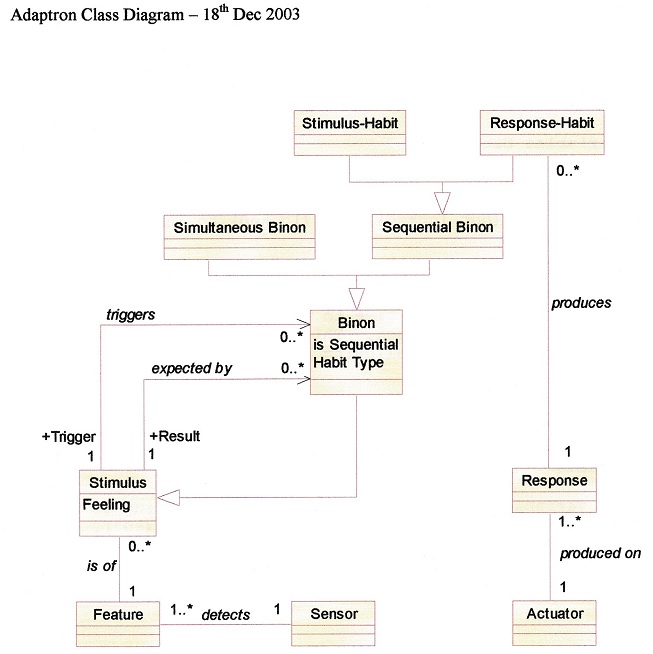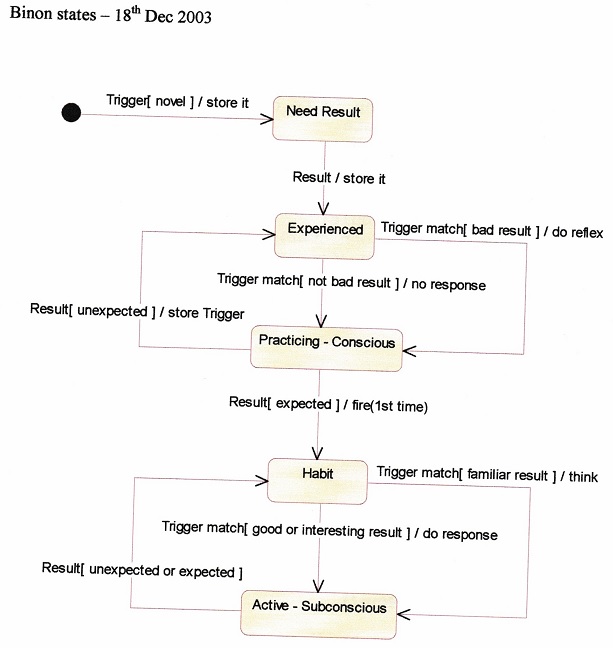2003
5th Feb. 2003
Expected stimulus not obtained /occur is a/produces a stimulus – a not satisfied expectation.
9th Feb. 2003
When each stimulus gets a combination of feelings – familiar + boring + not habitualized etc. – should do a pattern match on these combinations as though they are also stimuli that can have attention paid to.
The notes from loose leafs have been transferred here. Notes were written originally on 1st Feb, 2nd + 5th Feb.
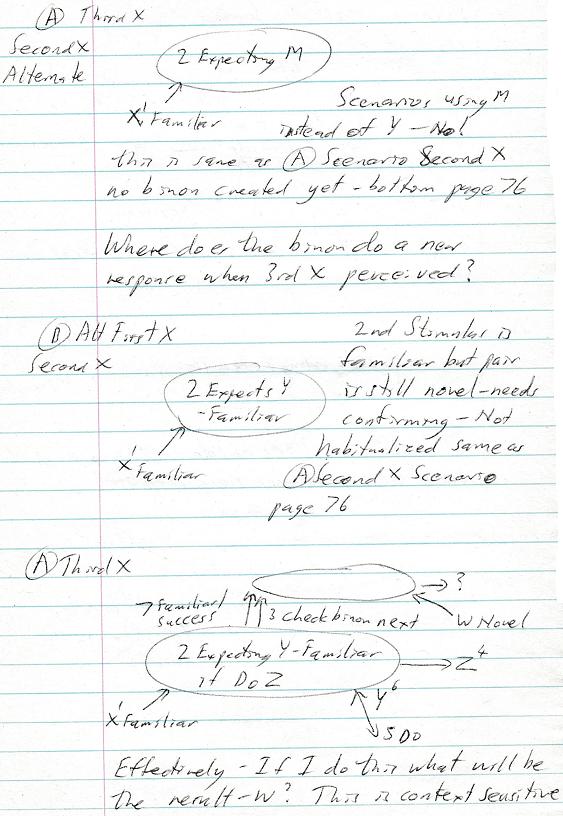
When 3 check binon – can get results
– has been habitualized or not,
– has familiar W or Novel W
If Not Habitualized + Novel W – Do consciously.
If Not Habitualized + familiar W – Do consciously
If Habitualized – Looked ahead and it is boring – do different new Z
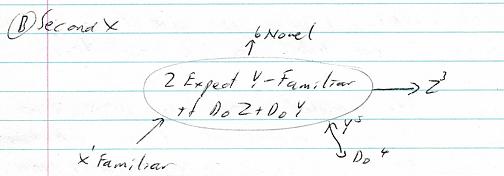
Even though Y familiar still does Z and Y to prove it is repeatable – The pair X, Y is what is novel. It is not as interested in doing it as it would have been, had the expected Y been novel.
So when X occurs nth time – many locations in LTM where occurred before some with
A Not habitualized – Y novel
B Not Habitualized – Y familiar
C Habitualized XZY as Habit H
C.1 H not habitualized – W Novel
C.2 H Not Habitualized – W Familiar
C.3 H Habitualized
If any A’s do most recent – consciously and all B’s, C’s that have the same Z remain active being done subconsciously. If no A’s then do most recent B etc. etc. If no A, B, C.1, C.2 only C.3’s then bored – no expectation of things to learn or novel results.
12th Feb. 2003 Distraction
When you are doing a current habit you are concentrating on it because you want to reach its expected goal or prove that it works repetitively. Other potential goals (habits) shouldn’t distract you from this current habit unless their goal is more desirable. Other potential goals (habits) with the same level of desirability and which do the same output could be started as habits in parallel.
22nd Feb. 2003 Testing
I now think scenario 2 is correct – when a habit fails we save it so far and pay attention to next stimulus on sense / feature that had unusual / unexpected stimulus.
23rd Feb. 2003 Context
The context is very similar to STM maybe it should be retained as such!
If one of the non-current habits completes – no context – it might (while current continues) make a better context than the one being performed.
Also not having context allows for reaction to recognized sub-patterns earlier. They don’t get delayed on the context list.
When 2 habits are active and one completes (the shorter one) and one continues (needs another stimulus to complete) the completed one attracts attention even if the longer one has yet to be habitualized.
25th Feb. 2003
If the current habit fails but another subconscious one, that has mirrored the current one so far, continues (not complete / recognized) then attention switches to the continuing one.
Although bottom pg 78 and pg 79 are intelligent decision / thinking to repeat / achieve a goal I think top of pg 77 is also a form of thinking to combine 2 unrelated habits!
Thinking is done with / on binons / habits that have been learnt / recognized / habitualized. One’s not habitualized can’t guarantee reproduction of their goal.
12th March 2003
This sequence could be recognized differently – may be some STM processing would allow it.
8th April 2003
Multiple habits running in parallel each has an expectation which it is trying to achieve – if any obtains an unexpected stimulus it becomes conscious. Each habit completes when its expectation is achieved. When it ends it does not necessarily become conscious. The actual resulting stimulus when experienced might attract attention. Each habit was started and told to run subconsciously to achieve its expected result. The conscious one however is [to] be practiced.
14th April 2003
After it has tried all possible actions in all possible situations shouldn’t every situation be familiar and all action / results be known, predictable and habits, so why would it continue to try any more actions? If it could think, wouldn’t it be going through all possible actions + results mentally and be caught in an infinite thinking loop? Or would it relegate the situations to the subconscious habits such as we don’t pay attention to our breathing, blinking, walking etc. Or would it stop reacting to the stimuli and just ignore it all because it is familiar? But then boredom would set in. I ignore stimuli only because it is part of the habit I am performing. I ignore the colour of the walls and the feeling of the seat below me because it is part of the habit. It could try actions again to avoid boredom. Will it try actions in different order than it has tried before? It knows what an individual action will produce in a single situation but there are an infinite variety of sequences of stimuli / actions.
The experience can be represented as a directed graph – A, B are stimuli
and a, b are the only 2 outputs and N is output nothing.
Given an algorithm which always avoids boredom it will continue to explore all possible higher order sequences by generating random output whenever bored. It will never come to the conclusion that all possibles have been tried. Exploration is good but only if it satisfies a higher goal – survival or increase pleasure, avoidance of pain.
I need to see if I can get it to learn a habit that goes in an infinite loop without creating boredom.
21st April 2003
The binons for doing an infinite loop would have to be like
When the 2nd is recognized it is the same as the 1st and the habit gets repeated.
23rd April 2003
Actual directed graph should include kinaesthetic stimuli.
26th April 2003 Goal directed, means end
Learn to recognize <– novel / familiar
Learn to do <– reward / punishment
Habitualized binons are started and execute subconsciously only if binon is in habitualized state – happened at least twice before! Once started then the mind starts to think.
Thoughts
We do remember thoughts because we can tell if we have thought them before. They are kept so we can learn, repeat them or they have established a shortcut trigger–goal that can be recalled without having to rethink it. We think in order to explore possible habit combinations that may lead to a possible result, e.g. A B, B C where B was not rewarded but C was. Expected B matches B stimulus as trigger of rewarding habit B C. This is forward thought exploring possibilities of what could be done. Then there is backward thought where Expected C is backwards chained to B and we think how can B be obtained as a result – what do I have to do to get a B which will result in a C. This is exploring the possibilities of what needs to be done.
20th June 2003
Need a binon that does not assume any order between the two inputs – just that they both occurred – theoretically simultaneously. They occurred at the same time so either one can and will trigger the expectation of the other. And when both occur the binon recognizes that. No opportunity to act – behave – perform action between the 2 stimuli input – purely a recognition binon.
30th June 2003
See the 2003 Scientific Research and Experimental Development (SR&ED) tax credit claim.
Details about the Canadian Revenue Agency’s SR&ED tax incentive program are here.
6th July 2003
Let us say we already have the following binon structure.
Where 1, 2, 3, 4, 5, 6 are stimuli and A E are binons. Then given stimulus 1 occurs recall idea 2 which matches with stimulus 2 triggering B resulting in stimulus 4 (which could be good or bad). If good then do A, get 2 – then consciously / practice / try and do B, get 4 (good) and B (now 5) has the idea of good associated with it. However when at the beginning we recall idea 2 this matches with resulting stimulus 2 on binon E which is saying if you want result 2 then in context of 6 do E. This is backwards chaining – could then do the same for idea 6 and backwards chain to current situation. This happens when someone asks you to put your thumb on your nose. You imagine the result and find the habit that does it for you with the triggering stimulus being the current situation. This needs words to produce the image of the result. The third possibility when stimulus 1 occurs is that you predict stimulus 3 occurring if you do A and 3 would result in a 4 if you do C.
13th July 2003
Actions are underlined.
Feeling conscious of:
Recall successful – associated info arrives
Recall unsuccessful – no association
Same as previous – attended to stimulus
Reward results in success (marking)
familiarity is a reward if trying to recognize
Punishment results in failure (marking)
Unfamiliar is punishment if trying to recognize
Unfamiliar is reward if trying to?
When recognizing – familiar is reward
– unfamiliar is – pay attention
expected familiar is
expected unfamiliar is
get next expected stimulus
get previous stimulus
effectively all navigation actions on a binon
binon actions
– given trigger stimulus
– change to habitualized
– get expected result stimulus
Trigger and result may be
simultaneous – unordered – different senses – sound and light
simultaneous – ordered – same sense – pitch and volume
sequential – time ordered – allows for action between
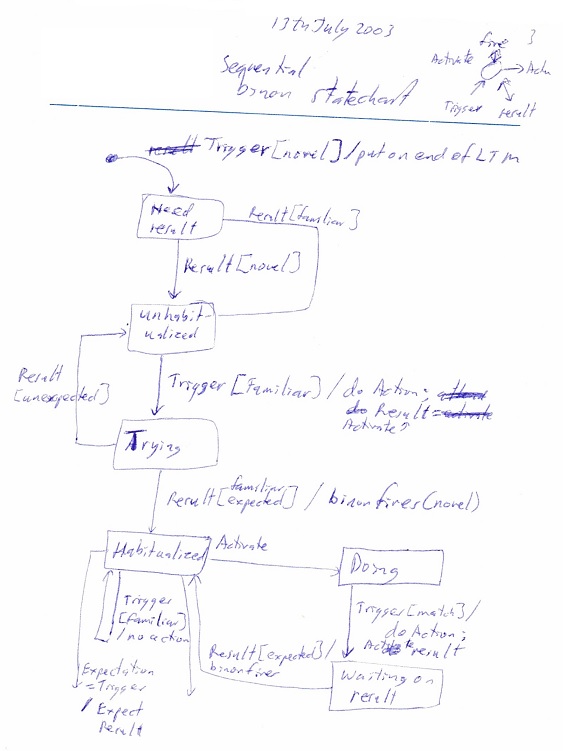

21st July 2003
Two kinds of simultaneous binons – unordered and ordered. The unordered ones have their 2 stimuli in either order and they will match any with the same 2 stimuli in the other order. The ordered simultaneous binon only matches another with the same order. The ordered simultaneous binon is used to recognize a change in a single dimension where relative differences are important i.e. detection of an edge, two notes with different pitch. The unordered simultaneous binon is used to recognize two stimuli that occur simultaneously of 2 different dimensions i.e. volume and pitch, texture and taste, smell and taste, colour and shape(edge). The association for novel/familiar with a stimulus is an unordered simultaneous binon. The ordered simultaneous binon is used for recognizing tunes.
22nd July 2003
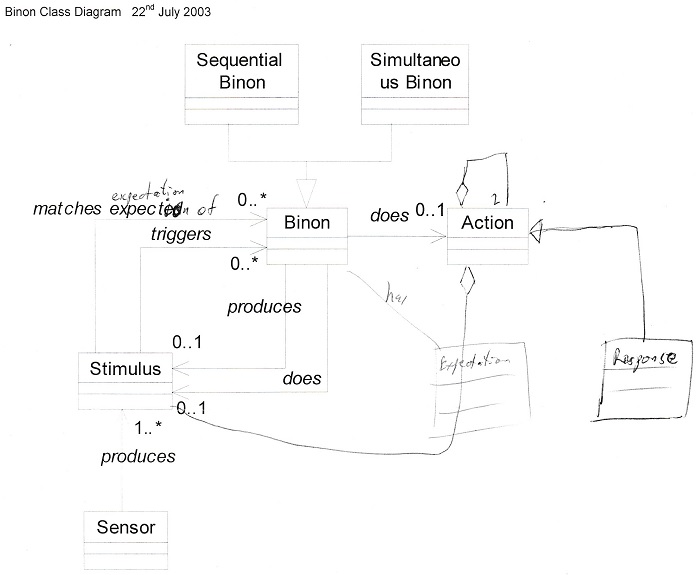
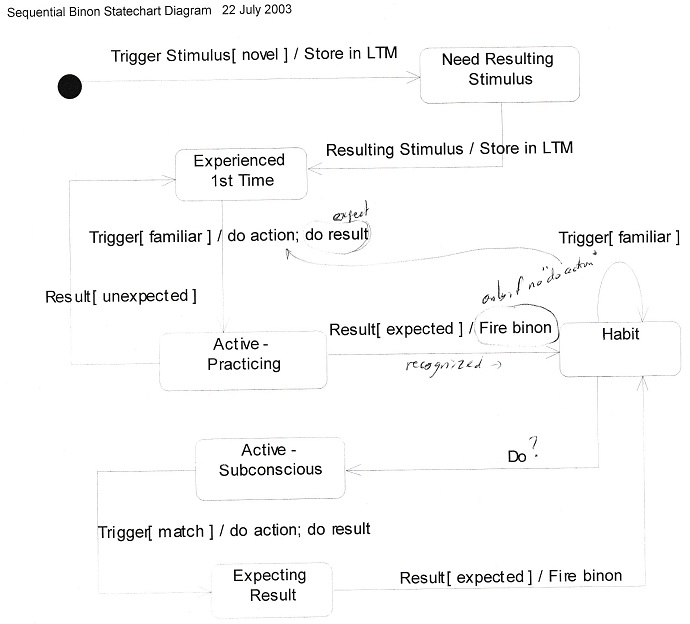

7th August 2003
Declarative versus procedural knowledge – stimuli and stimuli habits are declarative knowledge and responses and response habits are procedural knowledge.
R–Habits
I have decided that I need to implement R–Habits as described on Pg 53 et al [1st July 1999] to form a hierarchy of responses integrated with a hierarchy of stimuli.
9th August 2003
When a binon is being done the response is executed and then the resulting stimulus is done. Doing a stimulus is done by paying attention to the same sense + feature of the experienced one – expecting the same value. If it is the same then the binon is successful – gets the expected result = reaches the expected goal.
12th August 2003 Algorithm
Get stimuli (external) – recall – S–List
Clean up habit – continuing ones only
1. Unfamiliar external stimuli attract attention – store and go to 7
2. Match Habits
S–Habits collapse –> S–List
R–Habits complete – status = 2
3. Unfamiliar S–Habits attract attention – store and go to 7
4. If current habits
+ none got expected stimulus – change current habit to any continuing unconscious habit
– or if nonconscious ones attend to external stimulus or
other S–List stimulus (habit) – store and go to 6 – context + stop habits
+ got expected results – no new habits – go to 7
– R–Habit – store trigger stimulus
If collapsed/recognized/completed – no new habits and stop all active ones (new S–Habit) – continue at 5
5. Familiar S–Habits, then Input, then kinaesthetic (if can’t use familiar one/ not valid one – should get next familiar one)
Determine match/recall with greatest interest level
If not interesting – boredom – reflex response – store context – stop all active ones and go to 7
If more interesting – start new habit – store context – stop all actions and go to 6
else continue current habit (if any)
6. Add habits from S–List
7. Clean out S–List, do response
Repeat from top.
14th August 2003
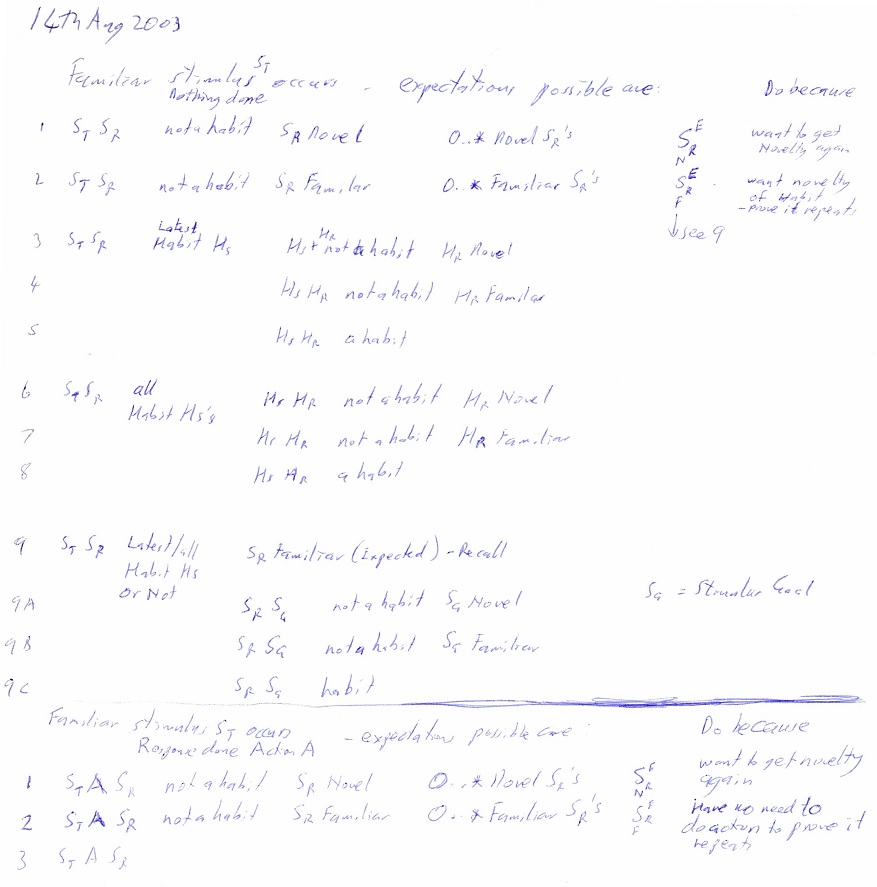
15th August 2003
An expectation is a goal if it is the objective of the habit. So goals are expectations to begin with and when the expectation is realized the “goal” (stimulus) has been achieved and the habit gets formed or proven. (successful)
Convert success of any kind into reward, then thinking driven by idea of reward.
Feeling of good or bad and ideas of such get attached to things (stimuli) that are goals – expectations – then the objective is to obtain such stimuli and when obtained, this results in success, which itself is associated with idea of good. – The feel good feeling.
Things to consider:
positive attraction of risk–taking or mild fear
positive attraction of problem solving or mild frustration
immediate drive value of thinking – reward in thinking maybe mild frustration
16th August 2003
18th August 2003
Play is an activity that is rewarded by novelty and dies off with familiarity. But it requires a non–deterministic [(10th Jan 2004) dynamic] environment or one which is infinite in its variety. So novelty can continue to be rewarding to behaviour in such an environment.
Orienting response – stop what you are doing – move head/arms, etc. to pay attention to novel stimulus. After it becomes familiar then stop responding.
Rotate through reflex responses list rather than random, so get to try them all.
When we go to repeat the response we delegate its production to the submind. It confirms the Sr but does not consume it so it is available to consciousness. The submind only interrupts the mind if a failure occurs!
Sr is consumed if we are practicing/concentrating on it to habitualize it.
No R–Habits should be started subconsciously unless “spun off” a consciously started R–Habit.
4th Sept. 2003

9th Sept. 2003
Continuing from page 83 April 14th. So what does an intelligent agent do when it finds itself in a 100% deterministic environment [(10th Jan 2004) static] and it has explored all the consequences of all its actions in all situations? Does it keep trying new combinations / sequences of outputs that it can think of? Or does this waste energy? Or does it become passive waiting for the environment to become non–deterministic (dynamic) (source of novelty)?
When I perform the habit “sit down” I expect a certain stimulus on my bum which from then on continues to be ignored as part of the sit down habit. The same happens (a loop) even if a response is involved such as in walking, pedalling. The “sitting down” contains a recognition loop.
Many stimuli are available at any one time for conscious attention but attention is only paid to those as a result of doing – practicing (consciously) a habit or it’s the best one to pay attention to. Best = most interesting = novel – potential.
The sub–mind executing habits subconsciously does not use up any stimuli – They are all available for conscious attention. Thus the “sit down” might complete subconsciously but bum feeling once 1st confirmed by the “sit down” habit are then ignored by conscious attention which has gone on to other thoughts or started other habits.
10th Sept. 2003
No! If we are not executing a subconscious recognition habit of “bum pressure” then how do we get alerted when there is a change in this stimulus?
Actual sensors [are] always transmitting current status, that being detected, continuously. Something has to recognize the signal and decide to ignore or sample. Something has to detect the change and decide if it’s worthy of attention. Background noise includes intermittent dog barking which is automatically ignored by my current habits.
11th Sept. 2003
Continuing from April 14th and Sept 9th. Conclusion is that: given that energy is not a concern it will keep on trying new combinations / sequences of responses as a result of thinking about the situation. How this thinking actually transpires I have yet to solve.
Can only start a habit and relegate it to the subconscious if it has been habitualized so when it completes it does not generate an unfamiliar (novel) stimulus (habit). And thus a completed subconscious habit goes unrecognized (the result is familiar) unless it has an associated pleasure feeling.
Unconscious Habit
1. Gets different value on sense expected – put this stimulus on S–List
– habit fails
2. Get expected value – continue unconsciously or complete a non–novel stimulus
3. Experience a loop – continue unconsciously – extend loop
4. Conscious habit produces different response – results in 1 above
Conscious Habit
1. Gets different value on sense expected
– same context and pay attention to unexpected stimulus
– either familiar – do experience (maybe)
– or novel – pay attention
2. Get expected value
– carry on with next expected consciously (to reach goal)
– habit complete – it’s new stimulus
3. Get loop – same as previous – ?
Stimuli on S–List – ones “used up” by unconscious habits are not paid attention to by consciousness unless
consciousness explicitly needs the value from that sense which it only does when executing conscious habits.
* Can only start a subconscious habit if it has been habitualized so that when a subconscious habit completes it does not generate an unfamiliar (novel) stimulus (habit)
21st Sept. 2003 from Heathrow Airport
3 stimuli in a row can be habitualized
Sequential recognition would favour the 1st scenario.
22nd Sept. 2003
Internal stimuli from movement of muscles are deterministic [static (10th Jan 2004)] except those to do with strain when moving weights – depend on external weight not action performed.
When thinking about what to do, do we only use habitualized experiences or do we use unproven ones also? Should be able to think about something that has only happened once before – want to remember it and recall it because it was a novel sequence at the time.
A habit fails when it does not get what it expected i.e. the resulting stimulus does not match the one in the habit. The habit then becomes conscious.
Reaching Goal – Once learnt – have a cue stimulus, then goal expectation and feeling (want to do it), then a ballistic do operation is done on learnt action sequence (which is delegated to sub–mind). Before it was learnt we have a cue stimulus, then expectation of goal stimulus which is known to be doable but uninteresting. This thought / expectation of goal acts as a cue associated with another 2nd expectation of goal and its feeling (want to do), then concentrate – do 1st uninteresting action sequence consciously and if get 1st expected uninteresting goal stimulus then do 2nd action sequence.
24th Sept. 2003
When a subconsciously executing habit completes – collapses to just 1 stimulus it does not create a stimulus on the S–List.
25th Sept. 2003
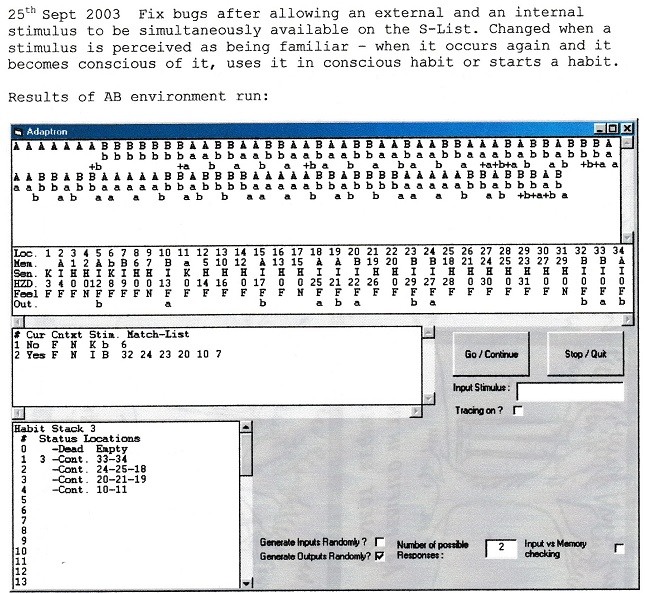
26th Sept. 2003 Habits
Idea – Start all matching stimuli as subconscious habits for all matches that have been habitualized and are only listening so as to ignore familiar stimuli. Can’t do the same for those that have actions, they need to be consciously started.
Habit Summary (see Sept. 11th notes)
Conscious and Unconscious
Conscious one is currently being done and the mind is concentrating on it – doing the response and expecting the resulting stimulus (Triggering stimulus has already been recognized).
Unconscious habits are executing in submind. They may be automatically or consciously started.
Automatically started ones can not contain any responses, i.e. recognition only and stop if response involved (maybe should not be started at all).
Consciously started may contain responses.
– Conscious habit can be doing unhabitualized memory trace (experience).
– Unconscious habits can only be doing habitualized habit (reason – see below).
Unconscious habit
Gets expected next stimulus, it continues unconsciously. If this is the last resulting stimulus of the habit, it completes and the habit collapses – put on S–List – see below. If the unconscious habit is a consciously started one containing responses and the response ends up failing because a conscious habit produces a different response, the unconscious habit will find out when it fails to receive the next expected stimulus. When an unconscious habit fails to receive the next expected stimulus (for whatever reason), the habit fails, stops and the actual unexpected stimulus is put on S–List (actually left on it). Stimuli on the S–List are consumed by unconscious habits but can still be used by conscious habits. Those not consumed or used by conscious habits are available to attract attention away from conscious habits. Those still left after next step in consciousness is done may be used to start automatically started habits.
To start an unconscious habit it must have been habitualized (proven) beforehand. So when it completes it will produce the resulting habit (upon collapse) and this resulting habit is familiar (obviously) and will not attract attention. But it will be put on the S–List even if it contained responses. The recognition–only ones (automatically started) may be triggering stimuli for the next automatically started habits. They will not attract attention, they are familiar.
The purpose of automatically started habits is to continuously ignore familiar stimuli and to place novel or unfamiliar stimuli (unfamiliar combinations of stimuli) on the S–List to attract attention.
The purpose of consciously started automatic habits is to allow the action/habit to be performed and obtain the resulting (desired) goal stimulus while freeing up the consciousness to think about what is being done, or what could also or as well be done.
The purpose of the conscious habit is to practice/repeat a non–habitualized desired action to see if the desired resulting goal stimulus is accomplished/accomplishable.
29th Sept. 2003
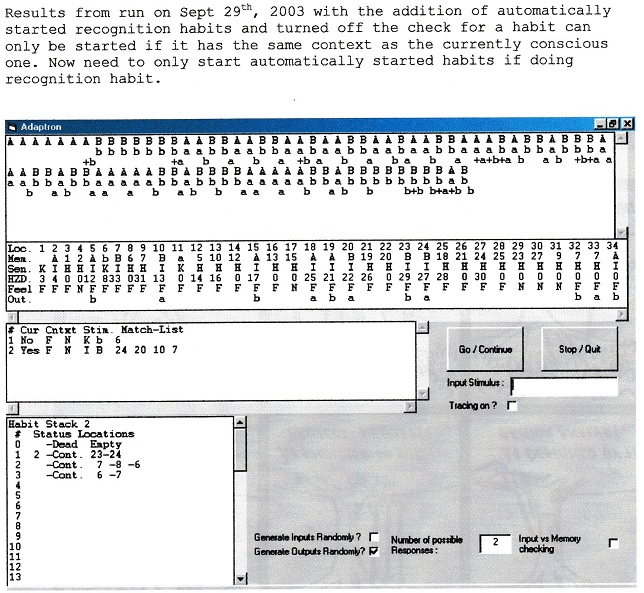
16th October 2003
Another purpose of automatically started recognition habits is to recognize more complicated stimuli (collapsed ones are put on the S–List) that may trigger a conscious habit or are familiar and need to be ignored (i.e. start another automatic recognition habit).
A response done by an unconscious habit is overridden by a response of a conscious one if it’s on the same muscle.
17th October 2003
While thinking about how to delegate the response and resulting stimulus to the subconscious and still have a conscious record of having instigated the action I realized that if the expectation of the resulting stimulus is recorded in LTM then it will serve this purpose. It would be initially recorded with the action when it is done as practice – habitualizing the action. It would be recorded by itself when repeating a habitualized behaviour. A question is – will it work for recognition only habits – should it?
19th October 2003
Simultaneous binons will lead to classical (Pavlovian) conditioning because of the occurrence of 2 stimuli at the same time – the unconditioned stimulus will start to trigger the action without the occurrence of the 2nd. Sequential binons are used to produce operant conditioning in which the consequences determine the learning.
29th October 2003

– All S–Habits are equally possible. No one is being concentrated on. There is the longest running one! and some starter ones?
– Ab but later second reflex Ab also recorded again!
+b +b
– Only need to practice/concentrate on single current habit if got response initially. Then getting unexpected stimulus needs to recognize/pay attention to what got instead.
If doing recognition concentration then all S–habitualized ones being done subconsciously and all unhabitualized are active (hoping for repeat).
If conscious/current habit(s) get(s) unexpected stimulus
– If they are S–habits – subconscious habits used up all necessary familiar ones – ignored
– subconscious habits fail and disappear
– active/current ones all fail and disappear
The familiar stimulus – unexpected and not ignored – not based on the sense of any active and failed S–Habit.
Save content and do familiar processing as though non–current/active
– If it’s an R–Habit – only one can be active
Save content and
Based on sense of active habit pay attention to unexpected, alternate stimulus
30th October 2003
Place R–habit in memory as negative reference – no need to check back in memory.
31st October 2003
Kinaesthetic stimuli – internal always change value when response produced. If no action/motion then they have same value which should be ignored – need a habit to recognize repeated kinaesthetic inputs or only supply an input when value changes else it is not known unless paid attention to.
One solution: Like all senses, they only generate a value when it changes so the senses do the ignore operation of unchanging stimuli. But if attention is consciously or unconsciously (no habit execution) paid to the sense then the current value is obtained. In case of external stimuli: the mind cycles such that after it finishes thinking of no conscious habit being done, it defaults to getting the input stimulus. Boredom results if it consciously gets the same familiar input.
Second solution: Why can’t a looping habit on the kinaesthetic stimuli be used to ignore repeated same values and this would leave different values on the stimulus list when a change occurs. However once the change has occurred twice it will also become a habit and the habit will be the item left on the S–List.
e.g. aaaaa –> a loop
ab –> b remaining (new)
ab –> second time b is consumed and new habit produced
For kinaesthetic habits to form first, then familiar stimuli checking should start with kinaesthetic stimuli, then external, then habits.
– Try this idea! Need second memory trace for kinaesthetic stimuli – its own mind (cerebellum)
Kinaesthetic inputs don’t cause boredom or pleasure but need to be recognized for feedback about successful actions. They don’t trigger new R–Habits. ?
1st November 2003
Decided to try and turn off kinaesthetic input and see what happens!
Found loop – but easier to understand.
2nd November 2003
Use expectations as cues to action habits.
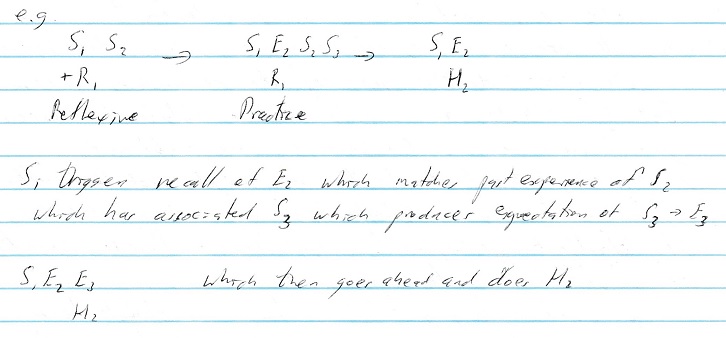
As part of practice if in reflexive situation S2 is familiar then have no interest in practice but E2 is recalled and maybe S3 is novel which will cause do of R1 (practice). If S2 S3 involves a response do it even if S2 S3 not practiced. If S2 S3 has no response, then still do it even if S2 S3 not habitualized.
When practicing on action should any automatically started recognition habits be running?
Possible reasons for doing when familiar stimulus found.
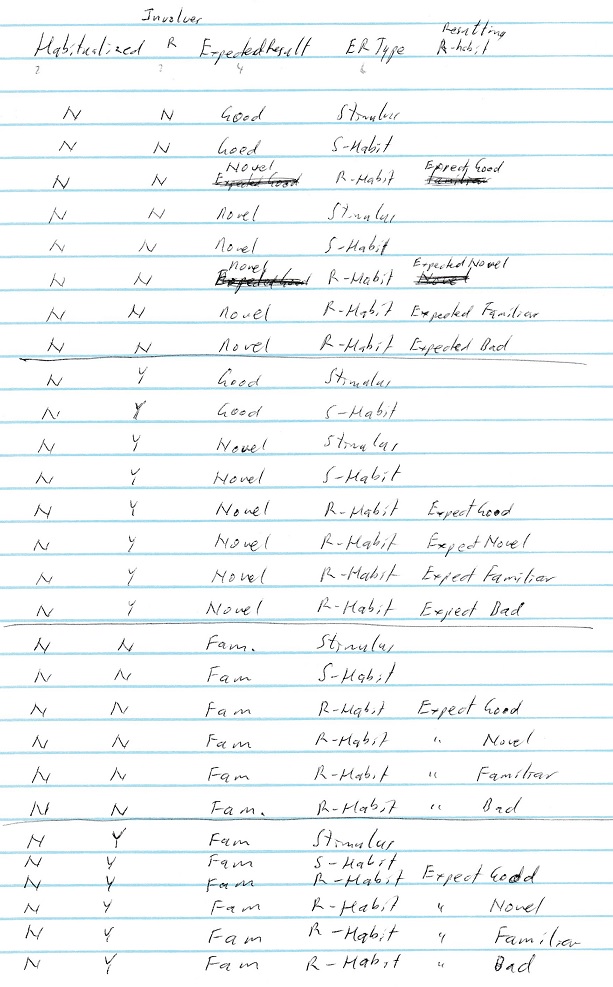
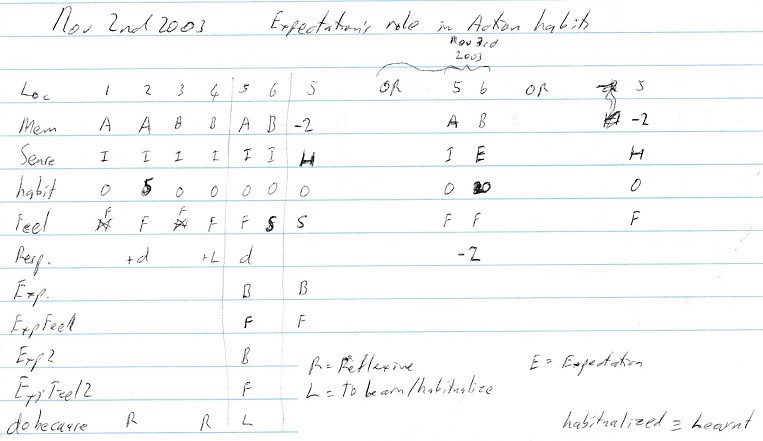
Possible reasons for doing when familiar stimulus found.
+ expected result is good – stimulus
– S–Habit
Experience not habitualized + expected result is novel – stimulus
– S–Habit
– R– Habit
Experience not habitualized + expected result (ER) is familiar
ER (expectation) recalled and examine matches in memory
Expected experience (EE) not habitualized + novel result
“ “ not habitualized + familiar result
EE habitualized
3rd November 2003
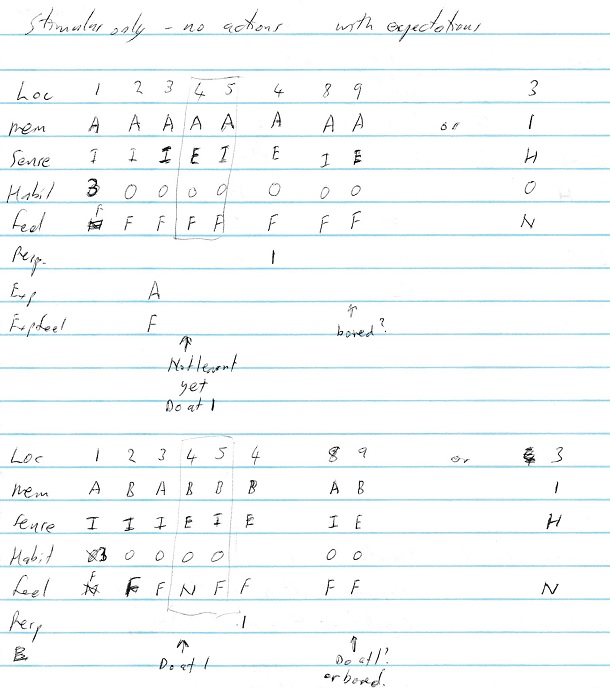
Explorer – 1
Treat the familiar stimulus as a new triggering stimulus.
There may be many familiar LTM locations on its S match list.
Those similar experiences and associated feeling are used to determine whether we perform the matching experience.
The following experiences are possible:
A. Experience is not habitualized and expected result is novel.
B. Experience is not habitualized and expected result is familiar
C. Experience is habitualized as a habit and this habit
C. 1 is not habitualized and its expected result is novel
C. 2 is not habitualized and its expected result is familiar
C. 3 is habitualized.
The INTERESTLEVEL is set as indicated “I = #”
I=4 For A we want to repeat it to experience the result again.
I=3 For B we want to prove the sequence (pair) is repeatable i.e. – habitualize it
I=2 For C. 1 we want to get into the situation where we might get a novel result.
I=1 For C. 2 we want to get into the situation where we can prove the subsequent sequence is repeatable.
I=0 For C. 3 by looking ahead in our experience we see nothing new so we are bored.
[note...I=2, I=1, I=0 – bored no response]
[note...I=1, I–0 – bored if does response]
In A & B the feeling associated with the expected resulting stimulus indicates if the memory trace is worth re–experiencing. I. e. novelty is equivalent to a reward. Definitely try it again. If it was familiar still repeat it to recognize it.
When doing reflexive response should find out if have done this response as a result of this stimulus in past experience – if have then repeating past experience, not doing a new version of it.
4th November 2003 / 1
If doing a non experience matching reference response, the resulting stimulus should not start any recognition habits, just focus on the simplest resulting stimulus.
Behaviour similar to network of binons
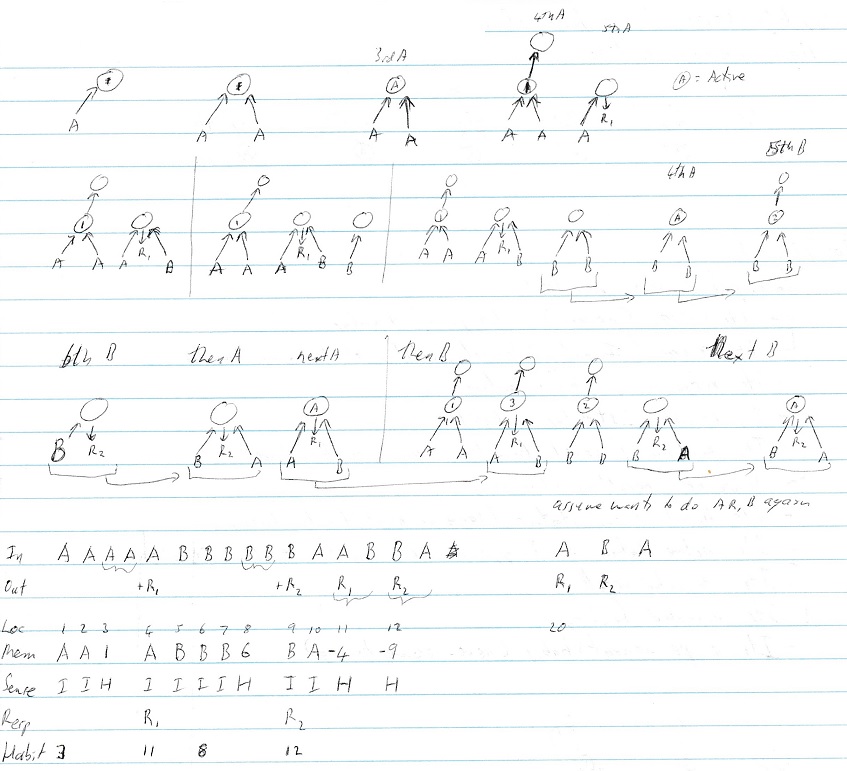
Seems to imply that a recall of a stimulus never matches a resulting stimulus of a pair that has been learnt.
Or matches of stimuli to resulting stimulus are only consumed by habits, not used to trigger behaviour.
4th November 2003 / 2
Behaviour based on networked binons
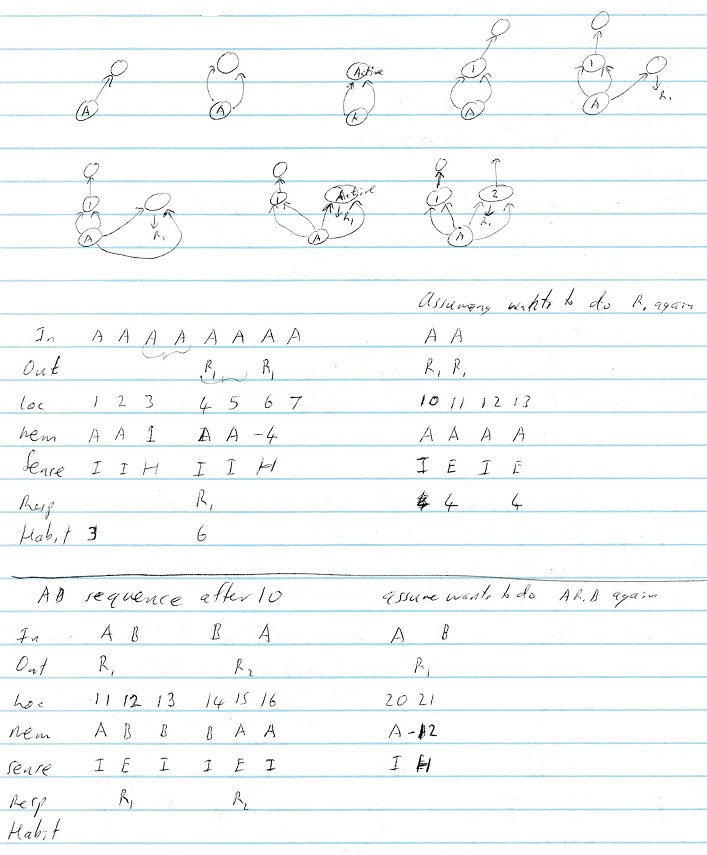
6th November 2003 a series of A’s
New memory is like

7th November 2003 – 1
Info. per binon needed
Its value (memory) – triggering stimulus – Its sense (input, internal, habit) of triggering stimulus
Its response (listen as action)
Its result (stimulus or habit) – Sense of resulting stimulus
Its feeling (novel, familiar (good, neutral, bad))
Its habitualized status (same as novel/familiar feeling)
Its active status – triggered – waiting for result – expecting
Its expected result
Its expected feeling
It’s a permanent S–habit (never becomes boring)

7th November 2003 – 2
Stages of binon after triggering stimulus
1. Listen – result novel
2. Listen – result familiar but proved it repeats
3. Listen – result familiar, so bored
4. Do response – result is novel
5. Do response – result familiar but proved it repeats
6. Do response – result familiar so bored – repeat at 4 for all responses
7. Listen – result familiar and proved and stay here
or
1. Listen – result novel
2. Listen – result familiar but now have proved it repeats
3. Result familiar and proved – delegate to submind
Boredom occurs when the expected result is not rewarding after it has been proven the result can be expected.
So need to habitualize the binon and the resulting stimulus is familiar (not rewarding so why do this action (listening))
How about good and bad? – An X has a bad feeling, a Y has a good feeling and all other stimuli are neutral.
Good and bad stimuli can’t be novel! It must be recognized to be seen as bad.

7th November 2003 – 3
After a binon is habitualized its execution is always delegated to the submind to be performed. Thus the conscious mind does not expect the resulting stimulus. The submind receives it and ignores/absorbs it. But the conscious mind must now pay attention to something. It could be an expectation (thought/idea), a habit or stimulus. This habit/stimulus is now treated as a triggering stimulus. If it matches a habitualized binon triggering stimulus we are consciously thinking of it. We may do the binon – give it to the submind to perform – or if it is already being done by the submind we are observing our own behaviour and applying our conscious decision criteria as to whether to repeat the past action or do something else. It’s like being aware of your habit of tying your shoelace. If at any point during the process you think of something else to try you actually vary the habit (try something else) and if you repeat it a second time consciously (practice it), it becomes a subconsciously repeatable habit. While you are paying attention to the habit you process all triggering stimuli consciously in parallel with the submind. Each step is repeated, provided it is expected to achieve the resulting stimulus and no other possible expected resulting stimulus has a higher interest level. Boredom occurs when the conscious mind starts to perform a habitualized binon that is expected to only produce a familiar resulting stimulus. This binon could be in the process of being performed by the submind or not, it is not relevant. Now conscious mind changes the response for this triggering stimulus/binon. When this response and resulting stimulus become learnt and also expected as familiar again the conscious mind tries another response, until all possible responses are tried and then it goes back to listening and marks binon as a permanent S–Habit for subconscious recognition of binon – pair of stimuli.
11th November 2003 Algorithm
0. Get stimuli (external) – recall and put matches on S–List
0a Clean up habits – keep the continuing ones
1. Novel external stimulus attracts attention – no habits continuing – store stimulus and go to 7.
2. Match habits
S–Habits collapse and put on S–List
3. Novel habits attract attention
Store habit and go to 7.
4. If practicing current habit(s) at interest level
4a. Did not get its next expected stimulus
Store content so far – no habits continuing
4b At least one got its next expected stimulus
It’s continuing – unless familiar stimulus more interesting
It’s complete – will be on S–List (familiar)
5. For all familiar habits and stimuli determine match with most interest
5a Repeat the most interesting – start as habit – practice or delegate
5b else boredom – reflex
5c Avoid bad, expected (fear?)
6. Start habits for any recognition (of learnt habits)
7. Output response (if any)
Repeat at top (0)
If don’t use internal stimuli to cause recognition habits to fail across responses then should exclude them as habits if response being made. If internal response used, need a simultaneous binon to recognize internal and external stimulus combined.
Changes needed as a result of no internal stimuli.
– If the conscious habit involves a response, it is being practiced and therefore no recognition habits can continue.
12th November 2003 Algorithm continued...
5. For all familiar habits and stimuli determine interest based on experience
5a Determine interest level for all familiar stimuli and matches not ignored by habits
Use the highest interest one(s)
If higher than current habit or no current habit
store context so far (if any) and start the new one(s) – one response or multiple recognition
– Practice it consciously if not learnt
– Start it subconsciously if learnt
Else continuing current habit
If not high enough and not permanent (not learnt/punished, learnt and familiar or punished)
Boredom or fear – do reflexive response
6. If no response being done start all learnt recognition habits for familiar stimuli matches not ignored
18th November 2003
Things to try next:
1. Good and bad stimuli
2. Start subconscious habits
2a. – S–Habits to ignore recognized stimuli
2b – R–Habits to reach desired goal
3. Thinking before starting an R–Habit
4. Thinking after starting an R–Habit
5. Simultaneous binons
4 – needs 2 done first
5 – leave until all else working
1 or 3 ? – 3 Thinking usually driven based on feeling/expectation – with good and bad working, thinking changes may be too complex
Let’s try 1 and get it working sensibly and then can turn it off (or just not reward/punish) and get 3 working – no subconscious – all current habit
6. Multiple S–Habits current if necessary – should get it working first – start all familiar S–Habits unlearnt as conscious
7. [added on 12th December 2003] – Back propagation of expectation of novelty and interesting as interesting stimuli
5. [added on 8th January 2004] – Do simultaneous binons for input and kinaesthetics
STM length of 3 so can recognize sequential S–Habits ABC or ABC
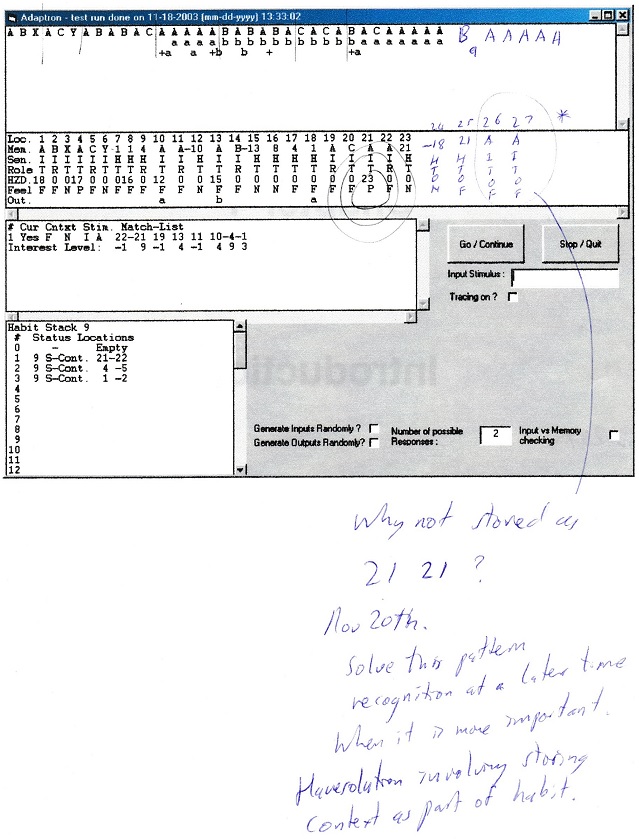
19th November 2003
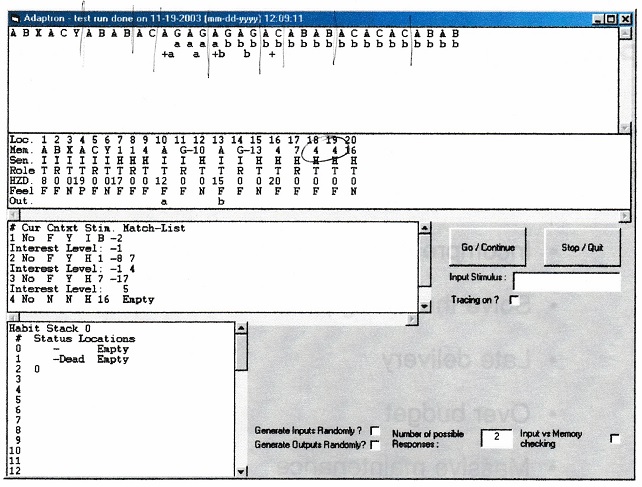
Problem with permanent S–Habits and best recognition.
20th November 2003
A permanent S–habit just means don’t do another reflexive boredom response when you get this stimulus, i.e. interest level > 4 so we do it as a habit – it never becomes boring! Set interest level to 5 for this situation.
22nd November 2003
Recognition binons – S–Habits go through the stages:
1. – 2 triggering stimuli (no response)
2. – binon recognized – learnt
3. – binon permanent – tried all possible responses Interest Level
1a. trigger new, result new repeat
1b trigger new, result familiar repeat
1c trigger familiar, result new repeat 7
1d trigger familiar, result familiar repeat 6
[note 1a –> 1d: curious]
2. trigger familiar, result familiar, recognized boredom 4 or 3
3a try next possible response
3b tried all responses – never bored again – permanent 5
With multiple stimulus experience matches starting habits what if we have one that needs repeating and one which will be boring?
Repeat it – if get result/confirmation of a 1 then that binon is now in state 2
– if get recognized one then binon fires but no boredom – it remains recognized/learnt but not permament
As long as something interesting could happen (new result) or habit is unlearnt we stay interested in listening – curious.
So can’t start boredom reflex actions until all S–Habits are boring
What if trigger stimulus starts multiple S–Habits?
Which are some boring (state 2) and at least one/some in (state 3) permanent – should not be possible. All the state 2 binons switch to state 3 when tried all responses. All become permanent.
If after permanent status get a novel resulting stimulus then it goes back to a repeat process until boredom occurs. When boredom occurs (recognized state 1 binon –> state 2) and then trigger occurs we have (it is possible) and since at least one is permanent this one is also permanent (don’t go through series of responses for it).
23rd November 2003
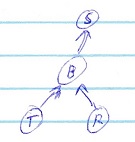
Each binon B has a feeling
N – novel if it has not occurred previously
If it’s novel then S does not exist, T must be familiar and R must be familiar
Binon B becomes familiar when T and R occur a second time and it fires producing S in novel state.
When B is novel it also has expected feeling – the one it got first time when R occurred – so its expected feeling is the one associated with R at the time R occurred
Then when binon gets T stimulus again its expected feeling is this R past experienced feeling.
B’s interest level in being done is based on expected R’s feeling and after B is done (R perceived) B’s feeling is updated based on R’s current feeling.
Interest level based on whether B is novel or learnt or become permanent or whether R expected as novel, familiar, permanent, good or bad.
B is R expected is Action May become
1 Novel Novel curious – repeat 5
2 Novel Familiar confirm – repeat
3 Novel Permanent confirm – repeat
4 Familiar (learnt) Novel impossible to occur
5 Familiar (learnt) Familiar bored – reflex
6 Familiar (learnt) Permanent
7 Permanent Novel impossible
8 Permanent Familiar
9 Permanent Permanent
24th November 2003
Interest levels – when familiar stimulus matches trigger location of binon
11. Not learnt – binon is novel = trigger location novel
Result stimulus feeling = good
10. Learnt – binon is familiar = trigger location familiar
Result = good
9. Not learnt – Result stimulus feeling = novel
* Not possible – it’s an experience [note added Dec 11th]
8. Not learnt – Result stimulus feeling = interesting
7. Not learnt – Result stimulus feeling = familiar or permanent
6. Learnt – Result stimulus feeling = interesting
5. Binon is permanent – Trigger location marked permanent
4. Learnt – Result stimulus feeling – permanent
3. Learnt – Result stimulus feeling = familiar OR a loop
2. Not learnt – Result stimulus feeling = bad
1. Learnt – Result stimulus feeling = bad
0. End of memory – binon incomplete
–1. Match with result
25th November 2003
Does a series of A’s get recognized as 
Whichever technique, it should be consistent to recognize 1,2,3,4,5,6 etc. As. But humans don’t recognize such patterns even if it may be logically useful. After 3 or 4 it’s just all boring – more of the same – no need to count them. It’s also a loop which should consciously do what a subconscious loop does – keep looping and ignore them. But if they are the only thing consciously perceivable then must go through response possibilities and then just ignore them. Human mind has to count (associate with integers) to be conscious of every repeating A.
27th November 2003
After experimenting with reward/punishment, I feel the need to implement the simultaneous binon to associated emotional feelings with stimulus. At least let’s investigate properties of simultaneous binons (S–B). When S–B receives its two stimuli the first time it forms an association between them. The second time it is familiar, a habit, confirmed, recognized and fires. It represents the combination or the difference between them. Now if just one of 2 input stimuli occurs, it is ½ cocked, ready, expecting the second input stimuli. If second occurs in certain time frame then it fires. But a simultaneous binon becomes useful in generalization/specialization. It continues to be relevant/useful if both stimuli are needed (specialization) (and) and not relevant if just one stimuli is useful (or) generalization.
When S–B punished we tend to generalize – either of 2 input stimuli are bad.
When S–B rewarded we tend to generalize – either of 2 input stimuli are rewarded and try it again to see if just one is good enough.
If get reward when just one stimulus is present we have generalized successfully.
Problem with punished S–B – we don’t try it again and thus generalize bad to both of 2 input stimuli.
How does an S–B get punished or rewarded? Every stimulus has the potential to be associated with (trigger) an emotional feeling stimulus.
So the 2 stimuli of an S–B each have an emotional feeling. If the combination of feelings are –> we get feeling transfer.
First Second Result First time Result Second time
Novel Novel Novel Familiar
Novel Familiar Novel Familiar
Familiar Familiar Novel Familiar
Familiar Bad First by itself expected bad. Second by itself is bad.
Bad Familiar vice versa
Familiar Good First by itself expected good. Second by itself is good
First by itself can trigger behaviour
First time it familiar. Second time learnt. It’s expected good.
Bad Good Depends on actual or expected – bad or good.
Actual usually neutralizes expected and then on second time it makes it expected the other one.
12th December 2003
Simultaneous binons start out in generalization mode. If binon rewarded then both input stimuli gain that feeling. Thus either / or will trigger that feeling and associated action. Then when just one is present it will trigger the action and three possibilities will occur.
1. Result is rewarded and the trigger stimulus gains individual reward feeling, or
2. Result is not rewarding – neutral – then it loses its interest/feeling (or it is reduced).
3. Result is punishing and trigger stimulus loses individual reward feeling and is now a bad stimulus (to be avoided). This process results in specialization of feelings about stimuli.
Q: Now what happens when both inputs of simultaneous binons have combinations of feelings? Extreme example – you are very hungry and see a poisonous snake and you have an instrument to catch/kill it, or legs to run away. Snake – feeling of fear (expected punishment/bad), Snake (food) – feeling of want/value (expected reward/good)
If it does known action for value trigger stimulus what’s the chances of bad result? Would not do action that caused fearful stimulus to become feared. (If just fearful stimulus would either not do anything (unless that is what caused it to be feared in the past) or do an alternate reflexive response (flee)).
13th December 2003
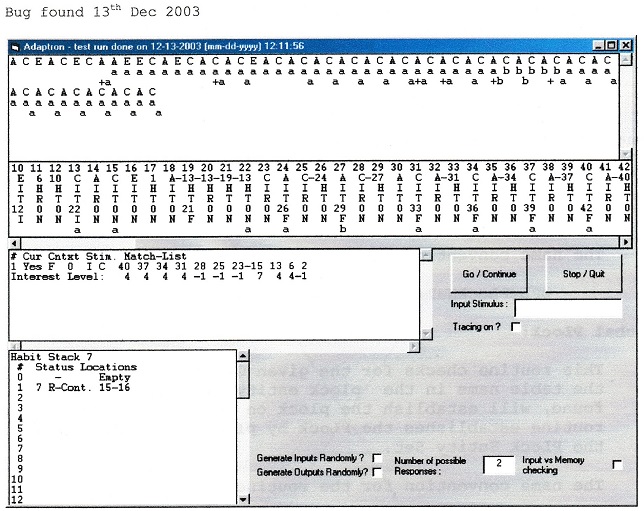
17th December 2003
If the result is the same as the trigger then confirm it by learning it but from then on we have a familiar result and it is the same as the trigger, i.e. no change. This is boring so such loops are worse than regular familiar resulting stimulus because no change. Don’t want to use them for thinking.
18th December 2003
